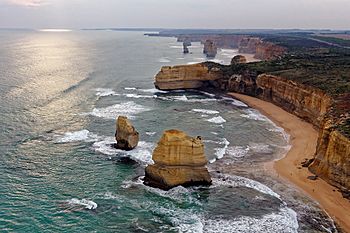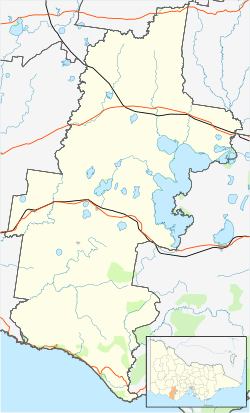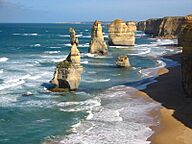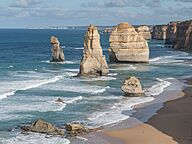The Twelve Apostles (Victoria) facts for kids
 |
|
|
Location within Shire of Corangamite and, inset, Victoria
|
|
| Geography | |
|---|---|
| Location | Near Port Campbell, Victoria |
| Coordinates | 38°39′57″S 143°06′16″E / 38.66583°S 143.10444°E |
| Administration | |
|
Australia
|
|
| State | Victoria |
| LGA | Shire of Corangamite |
The Twelve Apostles are amazing natural rock formations found off the coast of Victoria, Australia. They are located near Port Campbell National Park, along the famous Great Ocean Road. These giant rock pillars are made of limestone and stand tall in the ocean.
Many people visit this spot because the rocks are so close together, making it a very popular tourist attraction. Even though they are called the "Twelve Apostles," there were never actually twelve of them. Originally, there were nine stacks, but now only seven remain standing. You can see six of them clearly from the main viewing area.
What's in a Name?
These impressive rock stacks have had a few different names over time. At first, people called them the Pinnacles. They were also known as the Sow and Pigs, with a larger island called Muttonbird Island being the "Sow" and the smaller stacks being the "Piglets."
Later, the name "The Twelve Apostles" became official. This name was chosen to attract more visitors, even though there were only ever nine stacks. The name refers to the Apostles of Jesus.
How These Giant Rocks Formed
The Twelve Apostles are made from a type of rock called limestone. This limestone was formed a very long time ago, between 5 and 15 million years ago!
These rock formations were created by a process called erosion. The powerful waves and strong winds from the Southern Ocean constantly hit the cliffs. Over millions of years, this harsh weather slowly wore away the softer parts of the limestone cliffs. First, it created caves, then arches, and eventually, these arches collapsed. What was left behind were the tall, isolated rock pillars we see today, some reaching up to 50 meters (about 164 feet) high! The waves continue to erode these stacks, slowly changing them over time.
Recent Changes to the Apostles
Because of the ongoing erosion, the number of stacks has changed. In July 2005, one of the 50-meter-tall stacks collapsed into the ocean, leaving eight stacks. Then, in 2009, another stack fell, bringing the total down to seven.
Scientists believe that new rock stacks will form in the future. As the waves continue to erode the coastline, parts of the existing cliffs will eventually become new, separate rock pillars.
In March 2023, an important decision was made. The Federal Court of Australia officially recognized the Eastern Maar people as the traditional owners of a large area of land in Victoria, which includes the Twelve Apostles. This means their long history and connection to this special place are formally acknowledged.
See also
 In Spanish: Los Doce Apóstoles (Victoria) para niños
In Spanish: Los Doce Apóstoles (Victoria) para niños
- Gibson Steps
- London Bridge
- Loch Ard Gorge




